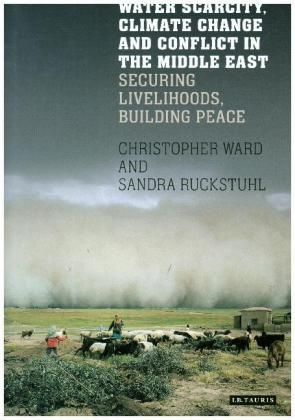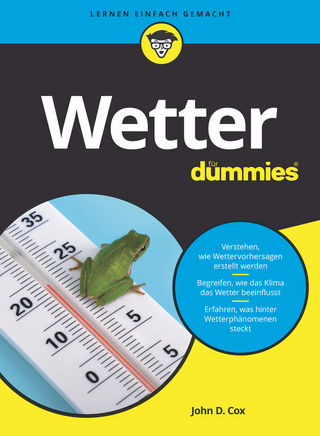
Water Scarcity, Climate Change and Conflict in the Middle East
I.B. Tauris (Verlag)
978-1-78453-776-0 (ISBN)
Christopher Ward is Honorary Research Fellow at the Institute of Arab and Islamic Studies, University of Exeter. He was educated at Whitgift, and at St John's College, Oxford and St Antony's College Oxford. Formerly with the World Bank, working largely in the field of natural resource management and rural development in the Middle East and Africa, he is currently consultant to a number of international organizations, including the World Bank and the United Nations Food and Agriculture Organization. He has lived in Yemen, Morocco, Saudi Arabia, Iran and Somalia, as well as Kenya, Madagascar and the USA. He is the author of The Water Crisis in Yemen: Managing Extreme Water Scarcity in the Middle East (I.B.Tauris, 2015). Sandra Ruckstuhl is a social development specialist who works with the World Bank, United Nations and US Government to improve conflict sensitivity of international development and humanitarian aid initiatives in the Middle East, Africa and Asia. She has specialized field experience supporting water and natural resource management projects, and has conducted analysis and provided operational guidance for programmes in more than 20 countries. She holds a PhD in Conflict Analysis and Resolution. She currently serves as Senior Social Specialist, Global Water Practice, World Bank, supporting programs in fragile, conflict-affected and transboundary contexts, and as Program Manager for the UN Sustainable Development Solutions Network's USA Sustainable Cities Initiative.
Contents
Introduction: Background on the Middle East & North Africa region
The countries of the region
A varied set of countries * Wide structural differences and diverse natural endowments
Global and regional trends
Sluggish growth, poor fiscal outlook and low investor confidence * Trade and food security *
Political change * Demographic trends and pressures * The effects of conflict
Water in the region
Water scarcity is a common thread * Demographic pressures are contributing to scarcity *
Economic changes are also exacerbating scarcity * The faint but clear voice of the environment and of water's ecological services * Water scarcity and climate change *
Water scarcity and the need for an integrated approach
Agriculture
The importance of agriculture in the Middle East & North Africa * Pressures on agriculture *
Agriculture and water scarcity * Agriculture and climate change * Competition for water and the case for transfer of water out of agriculture * Agriculture and rural poverty *
Perceived links between water, agriculture and food security
Water and conflict
PART I: CHALLENGES
Chapter 1: The challenge of water and agriculture and the drivers of water scarcity
Water resources and uses
Water uses by sector
Climate and farming systems
The contribution of agriculture
Food security and agricultural water management
Food production and consumption in the Middle East & North Africa * Food security and insecurity * Impacts of conflict on food security * Can food insecurity drive conflict? *
Links between agriculture and food security
Recent trends: an agriculture already under stress
Land and water use in agriculture * Productivity, technology and innovation * Market orientation * Policies, institutions and public goods * Agricultural heritage and conservation
Irrigation in the Middle East & North Africa
The importance of irrigation in the region * Agricultural water withdrawals * Types of irrigation in the region
Drivers of scarcity and the challenge of water for agriculture
Chapter 2: Climate change and its expected impacts on the farming systems of the region
Climate change events anticipated in the Middle East & North Africa
Expected impacts of climate change on agricultural water and farming
Water resources * Irrigation * Crop and livestock yields and production * Impacts by farming system
Readiness for climate change
Strategic preparedness
Research on issues of agriculture and climate change
The region's contribution to climate change
Chapter 3: Water and conflict in the Middle East and North Africa
A deadly water conflict
The nature and role of conflict in the water sector of the region
Why does conflict so often arise over water?
The nature of the resource * Social and institutional specifics of water * Political economy and power relations over water
Types of water conflict in the region
A classification of transboundary conflict * A classification of conflict at the national or sectoral level * A classification of conflict at the local level
The challenge of transboundary water
A fertile field for conflict in the region * Scant cooperation to date * Pointers for the future
Conflict at the national or inter-sectoral level
Conflicts over access to water and water-related services * Conflict of water-related policy with other interests * Conflict with environmental needs or resource sustainability
Conflict at the local level
Conflicts arising from local adoption of new technology * Conflict provoked by state intervention at the local level
Growing pressures to water conflict in the region
Changes in patterns of demand * Changes on the supply side * The changing institutional context and power relations
Water and conflict in the Syrian crisis
Water and the causes of the Syrian crisis * The role of drought in the Syria crisis *
How could this happen in a country that has so developed its water resources for agriculture? * Conclusion: water issues and the Syrian crisis
PART II: OPTIONS
Chapter 4: Policies and institutions for managing water resources for agriculture
Bringing integrated management to bear on agricultural water management to promote efficiency
Global best practice: integrated water resources management * The goals of IWRM *
Three IWRM principles * Implementing IWRM * IWRM in the region
Overall water governance and institutions in the Middle East & North Africa
IWRM and the basin approach
Subsidiarity, decentralization and participation
Acting on the supply-side drivers of scarcity
Mobilizing new supplies * Non-conventional sources of water for agriculture
Groundwater depletion
The incentive framework for promoting water use efficiency and water productivity in agriculture
Irrigation water pricing * Protection of domestic production * Energy subsidies *
Adjusting the entire incentive structure
Chapter 5: Water use efficiency and crop water productivity in agricultural water management
Water use efficiency and water productivity
Water use efficiency * Improving water use efficiency * Crop water productivity and how to improve it * Entry points for further increasing water use efficiency and water productivity in the region
Surface irrigation: increasing water use efficiency and closing the yield gap through modernization
Comparing the performance of irrigation in the region with global performance * Emerging constraints and opportunities: water user associations * Emerging constraints and opportunities: the nexus of energy and agricultural water management* Emerging constraints and opportunities: financing operations and recovering costs from farmers *
Planning for irrigation modernization * Elements for an action plan * Applying MASSCOTE in the region
Pressurized irrigation and high value agriculture
Options for future development
Sustainable groundwater irrigation
The advantages of groundwater * The problems of groundwater * Groundwater in Saudi Arabia * Groundwater boom and bust in Yemen * Options for future groundwater management
Lower cost energy options for irrigation
Rainfed agriculture
Soil moisture management * Rainwater harvesting * Supplementary irrigation * Soil fertility * Integrated soil, crop and water management * Improving productivity and adapting to climate change in rainfed farming in the region * Technology, institutional adaptation and the research agenda * What next?
The challenge of soils and land degradation
Status of soils in the region * Factors driving soil degradation * Causes of degradation *
Costs of soil degradation * Responses to degradation
Watershed management and water management in the region's drylands
Watershed management * Payment for Environmental Services (PES) * Water and forestry *
Water in the drylands * Water, pastoral systems and desertification
Salinization, waterlogging and drainage
Reasons for neglect of drainage * The case for drainage in the region * Good practice: policy issues and trade-offs * Technology and investment choices * Drainage water reuse
Chapter 6: Adapting to climate change in the Middle East and North Africa
Adaptation options for farming systems and rural households
Likely farmer adaptations in agriculture * Technological and institutional adaptation *
Adaptation by farming system: highland and rainfed mixed systems * Adaptation by farming system: dryland mixed systems * Adaptation by farming system: pastoral systems *
Adaptation by farming system: irrigated agriculture
Household-level livelihood strategies
Farm incomes * Off-farm rural activities * Exit from farming and rural to urban migration
Strategies for adapting agriculture under climate change
Climate modelling and resource monitoring * Preparation of adaptation and mitigation strategies
Policies and programmes to support farmers in adapting agricultural practices
Research, extension and information * Learning from and with farmers * Finance
Increasing water productivity through integrated water resources management under climate change
Managing water allocations for agriculture * Increasing water supplies for agriculture *
More sustainable groundwater management * Improving irrigation water use efficiency
Adapting institutions: decentralization and community collaboration
Policy level issues for adaptation
Virtual water, trade liberalization and market development * Promoting poor people's access to product markets
Regional and international cooperation on climate change affecting agriculture
Research * Coordinated policies and actions * River basin cooperation
Innovative approaches
New partnerships and mechanisms * Combining adaptation and mitigation
Paris 2015
Financing for adaptation
Carbon markets * Markets in environmental services
Climate change mitigation and the agricultural carbon footprint
Broader policies and programmes to sustain rural livelihoods
Food security and climate change
The food security challenge in the region's poorest country * Food security and the middle income Arab countries * Better off countries and food security
Coping with the food security crisis in Syria and neighbouring countries affected by the crisis
Starting recovery with the rural and agriculture sector * Building resilience as the basis for rural food security * A strategic approach * Harnessing the opportunities * Can rebuilding food security contribute to peacebuilding?
Conclusion
Chapter 7: Water conflict resolution
Options for managing and resolving conflict
A framework for conflict management and resolution * Is conflict a help? * Best practice in water management as a pathway to conflict resolution
From conflict to cooperation on transboundary waters
Transboundary cooperation in practice: the case of the West Bank aquifers
The failure of the Joint Water Council as a forum for integrated water resource management * Constraints to Palestinian water investment and services * Who is really in control of West Bank water? * Lessons from Article 40 and the West Bank
Cooperation on the Nile: experience and lessons
The importance of cooperation on the Nile * History of Nile cooperation * Nile Basin Initiative (NBI) governance * Investments and results 2002-15: what has been achieved? *
Institutional development: what has been achieved? * Constraints and overcoming constraints * Impact of cooperation on the Nile * Current risks and future risk management
Lessons learned: lessons on the process of negotiating cooperation on transboundary waters * Lessons learned: how to tackle the substantive cooperation issues * Last word on the Nile
The problem of the Euphrates
The cause and urgency of the Euphrates problem
No equivalent `Tigris problem' The failed history of cooperation on Euphrates waters * Framework for action * The weaponization of international waters: effects of the crises in Syria and Iraq on the Euphrates and Tigris
Resolving conflict through good water management within the nation National level solutions from the top: infrastructure, institutions, accountability * Infrastructure * Institutions: integrated water resources management and legal water rights * Water markets * Demand management: regulation * Demand management: the incentive framework * The characteristics of formal institutions adapted to good water management and to conflict resolution * Integrating water governance from the bottom up * The case of water user associations * Implementing reforms to improve water management and resolve water conflict
When nations fall apart - the role of water governance in easing tensions in the Syria conflict
Conclusion
Chapter 8: Peacebuilding through water governance
Peace, peacebuilding and environmental peacebuilding
Environmental peacebuilding strategy
Capacities for collaborative governance * Practicalities: Taking advantage of the context *
Maximizing operational approaches * Conclusion
PART III: NEXT STEPS
Chapter 9: An agenda for change
Organization of the chapter
Managing water resources for agriculture in the Middle East & North Africa: gaps and options
Governance and institutions * IWRM and the basin approach * Subsidiarity, decentralization, participation * Acting on the supply-side drivers of scarcity * Tackling groundwater depletion * The incentive framework for water use efficiency and water productivity in agriculture
Improving water use efficiency and crop water productivity
Water use efficiency and water productivity * Surface irrigation: increasing water use efficiency and closing the yield gap through modernization * The energy/water nexus *
Pressurized irrigation * Rainfed agriculture * Watershed management * Water in the drylands and anti-desertification * Water and forestry * Drainage and drainage water reuse
Are these new approaches to agricultural water management?
New approaches * The contribution of regional collaboration
Scope to adapt to climate change
Farmer responses * Government role in supporting farmers * Household-level livelihood strategies * Food security under climate change * Implications for policy and programmes
Resolving conflict over water
From conflict to cooperation on transboundary waters * Options for managing transboundary conflict * Resolving conflict through good water management within a country's borders
Peacebuilding
Difficult policy choices and deciding on trade-offs
Productivity v. food self-sufficiency * Free trade v. protection * Managing trade-offs and aligning incentives
Creating momentum for change
Drivers of change in the water sectors of the countries of the Middle East & North Africa *
Introducing best practice water policies: lessons from Australia
Bibliography
Index
| Erscheinungsdatum | 05.07.2017 |
|---|---|
| Zusatzinfo | 30 black and white integrated illustrations |
| Sprache | englisch |
| Maße | 159 x 254 mm |
| Themenwelt | Sachbuch/Ratgeber ► Natur / Technik ► Natur / Ökologie |
| Naturwissenschaften ► Biologie ► Ökologie / Naturschutz | |
| Naturwissenschaften ► Geowissenschaften ► Geografie / Kartografie | |
| Technik ► Umwelttechnik / Biotechnologie | |
| ISBN-10 | 1-78453-776-4 / 1784537764 |
| ISBN-13 | 978-1-78453-776-0 / 9781784537760 |
| Zustand | Neuware |
| Haben Sie eine Frage zum Produkt? |
aus dem Bereich


